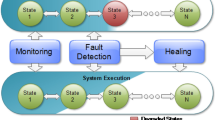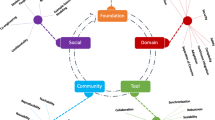Abstract
Appropriate maintenance technologies that facilitate model consistency in distributed simulation systems are relevant but generally unavailable. To resolve this problem, we analyze the main factors that cause model inconsistency. The analysis methods used for traditional distributed simulations are mostly empirical and qualitative, and disregard the dynamic characteristics of factor evolution in model operational running. Furthermore, distributed simulation applications (DSAs) are rapidly evolving in terms of large-scale, distributed, service-oriented, compositional, and dynamic features. Such developments present difficulty in the use of traditional analysis methods in DSAs, for the analysis of factorial effects on simulation models. To solve these problems, we construct a dynamic evolution mechanism of model consistency, called the connected model hyper-digraph (CMH). CMH is developed using formal methods that accurately specify the evolutional processes and activities of models (i.e., self-evolution, interoperability, compositionality, and authenticity). We also develop an algorithm of model consistency evolution (AMCE) based on CMH to quantitatively and dynamically evaluate influencing factors. Experimental results demonstrate that non-combination (33.7% on average) is the most influential factor, non-single-directed understanding (26.6%) is the second most influential, and non-double-directed understanding (5.0%) is the least influential. Unlike previous analysis methods, AMCE provides good feasibility and effectiveness. This research can serve as guidance for designers of consistency maintenance technologies toward achieving a high level of consistency in future DSAs.
Similar content being viewed by others
References
Al-Jaroodi, J., Mohamed, N., 2012. Service-oriented middleware: a survey. J. Network Comput. Appl., 35(1):211–220. [doi:10.1016/j.jnca.2011.07.013]
Asiki, A., Doka, K., Konstantinou, I., et al., 2009. A grid middleware for data management exploiting peer-to-peer techniques. Future Gener. Comput. Syst., 25(4):426–435. [doi:10.1016/j.future.2008.09.005]
Atzori, L., Iera, A., Morabito, G., 2010. The Internet of Things: a survey. Comput. Networks, 54(15):2787–2805. [doi:10. 1016/j.comnet.2010.05.010]
Beimel, D., Galanti, L., 2007. A consistency-preserving protocol for distributed collaborative model authoring. Proc. Int. Conf. on Systems Engineering and Modeling, p.118–126. [doi:10.1109/ICSEM.2007.373341]
Brandt, C., Hermann, F., Engel, T., 2009. Security and consistency of it and business models at Credit Suisse realized by graph constraints, transformation and integration using algebraic graph theory. Proc. 10th Int. Workshop on Business Process Modeling, Development and Support, p.339–352. [doi:10.1007/978-3-642-01862-6_28]
Ceranowicz, A., Cutts, D.E., Graff, J., et al., 2012. A proposal for a data exchange model representation standard. Proc. Spring Simulation Interoperability Workshop, p.143–155.
Chen, J.W., 2011. Comparison analysis for validating methods of system simulation models. Proc. Int. Conf. on Electric Information and Control Engineering, p.232–235. [doi:10.1109/ICEICE.2011.5778078]
Cheun, D.W., La, H.J., Kim, S.D., 2012. A taxonomic framework for autonomous service management in service-oriented architecture. J. Zhejiang Univ.-Sci. C (Comput. & Electron.), 13(5):339–354. [doi:10.1631/jzus.C1100359]
Cicirelli, F., Furfaro, A., Nigro, L., 2011. Modelling and simulation of complex manufacturing systems using statechart-based actors. IEEE Trans. Softw. Eng., 19(2): 685–703. [doi:10.1016/j.simpat.2010.10.010]
Dam, H.K., Ghose, A., 2011. An agent-based framework for distributed collaborative model evolution. Proc. 12th Int. Workshop on Principles on Software Evolution, p.121–130. [doi:10.1145/2024445.2024468]
Ding, J., Chen, L., Zhou, F., et al., 2005. Consistency analysis of complex declarative simulation models. J. Softw., 16(11):1868–1875 (in Chinese). [doi:10.1360/jos161868]
Engels, G., Kuster, J.M., Heckel, R., et al., 2002. Towards consistency-preserving model evolution. Proc. 5th Int. Workshop on Principles of Software Evolution, p.129–132. [doi:10.1145/512035.512066]
Fan, L., Ling, Y., Wang, T., et al., 2013. Novel clock synchronization algorithm of parametric difference for parallel and distributed simulations. Comput. Networks, 57(6): 1474–1487. [doi:10.1016/j.comnet.2013.02.004]
Foster, H., 2003. Semantic inconsistency and its effect on simulation. IEE Electron. Syst. Softw., 1(2):18–21. [doi:10. 1049/ess:20030209]
Guo, J., Wang, Y., Trinidad, P., et al., 2012. Consistency maintenance for evolving feature models. Expert Syst. Appl., 39(5):4987–4998. [doi:10.1016/j.eswa.2011.10.014]
Hermann, F., Ehrig, H., Orejas, F., et al., 2011. Correctness of model synchronization based on triple graph grammars. Proc. 14th Int. Conf. on Model Driven Engineering Languages and Systems, p.668–682. [doi:10.1007/978-3-642-24485-8_49]
Law, A.M., 2005. How to build valid and credible simulation models. Proc. Winter Simulation Conf. [doi:10.1109/WSC.2005.1574236]
Lu, Y., Hao, Z.X., Dai, R., 2007. A sufficient and necessary condition for the absolute consistency of XML DTDs. Proc. 8th ACIS Int. Conf. on Software Engineering, Artificial Intelligence, Networking, and Parallel/Distributed Computing, p.249–254. [doi:10.1109/SNPD.2007.104]
Mens, T., Wermelinger, M., Ducasse, S., et al., 2005. Challenges in software evolution. Proc. 8th Int. Workshop on Principles of Software Evolution, p.13–22. [doi:10.1109/IWPSE.2005.7]
Morse, K.L., 2005. XMSF profile study group final report. Technical Report No. 05F-SIW-013. Science Applications International Corporation, San Diego, CA, United States.
Singh, H.L., Gracanin, D., 2012. An approach to distributed virtual environment performance modeling: addressing system complexity and user behavior. Proc. 19th IEEE Virtual Reality Conf., p.71–72. [doi:10.1109/VR.2012. 6180887]
Strassburger, S., Schulze, T., Fujimoto, R.M., 2008. Future trends in distributed simulation and distributed virtual environments: results of a peer study. Proc. Winter Simulation Conf., p.777–785. [doi:10.1109/WSC.2008.4736 140]
Swinerd, C., McNaught, K.R., 2012. Design classes for hybrid simulations involving agent-based and system dynamics models. Simul. Model. Pract. Theory, 25:118–133. [doi:10. 1016/j.simpat.2011.09.002]
Tolk, A., Turnitsa, C.D., Diallo, S.Y., 2006. Ontological implications of the levels of conceptual interoperability model. Proc. 10th World Multi-conf. on Systemics, Cybernetics and Informatics, p.105–111.
Trollmann, F., Albayrak, S., 2011. Expressing model relations as basis for structural consistency analysis in Models@Run. Time. Proc. ACM/IEEE 15th Int. Conf. on Model Driven Engineering Languages and Systems, p.74–75. [doi:10.1145/2422518.2422530]
Uhlig, A., Rude, E., 2009. Semi automatic reliability analysis based on simulation models. Proc. Int. Conf. on Computer Applications in Shipbuilding, p.78–116.
Wang, J.Z., Varman, P., Xie, C.S., 2011. Optimizing storage performance in public cloud platforms. J. Zhejiang Univ.-Sci. C (Comput. & Electron.), 12(12):951–964. [doi:10. 1631/jzus.C1100097]
Wei, O., Gurfinkel, A., Chechik, M., 2011. On the consistency, expressiveness, and precision of partial modeling formalisms. Inf. Comput., 209(1):20–47. [doi:10.1016/j.ic. 2010.08.001]
Weidlich, M., Mendling, J., Weske, M., 2011. Efficient consistency measurement based on behavioral profiles of process models. IEEE Trans. Softw. Eng., 37(3):410–429. [doi:10.1109/TSE.2010.96]
Wu, Z.H., Chen, H.J., 2012. From semantic grid to knowledge service cloud. J. Zhejiang Univ.-Sci. C (Comput. & Electron.), 13(4):253–256. [doi:10.1631/jzus.C1101006]
Yan, J., 2005. Consistency and interoperability checking for component interaction rules. Proc. 12th Asia-Pacific Software Engineering Conf., p.595–602. [doi:10.1109/APSEC.2005.55]
Yu, H., Vahdat, A., 2002. Design and evaluation of a conit-based continuous consistency model for replicated services. ACM Trans. Comput. Syst., 20(3):239–282. [doi:10. 1145/566340.566342]
Yu, P., Ma, X., Cao, J., et al., 2013. Application mobility in pervasive computing: a survey. Perv. Mob. Comput., 9(1):2–17. [doi:10.1016/j.pmcj.2012.07.009]
Zhang, X., Ward, T., McLoone, S., 2009. Exploring an information framework for consistency maintenance in distributed interactive applications. Proc. 13th IEEE/ACM Symp. on Distributed Simulation and Real-Time Applications, p.121–128. [doi:10.1109/DS-RT.2009.23]
Zhong, W., Huang, K., 2012. Research on OWL-based BOM ontology model. Proc. 2nd Int. Conf. on Computer Application and System Modeling, p.1189–1193.
Zhou, D.X., Zhong, H., Deng, R., et al., 2007. Survey of simulation composability of complex systems. J. Syst. Simul., 19(8):1819–1823 (in Chinese).
Zhou, S.P., Cai, W.T., Lee, B.S., et al., 2004. Time-space consistency in large-scale distributed virtual environments. ACM Trans. Model Comput. Simul., 14(1):31–47. [doi:10.1145/974734.974736]
Author information
Authors and Affiliations
Corresponding author
Additional information
Project supported by the National Natural Science Foundation of China (No. 61272336)
Rights and permissions
About this article
Cite this article
Fan, Lj., Ling, Yx., Zhang, Xt. et al. Quantitative evaluation of model consistency evolution in compositional service-oriented simulation using a connected hyper-digraph. J. Zhejiang Univ. - Sci. C 15, 1–12 (2014). https://doi.org/10.1631/jzus.C1300089
Received:
Accepted:
Published:
Issue Date:
DOI: https://doi.org/10.1631/jzus.C1300089
Key words
- Model consistency evolution
- Factor quantification analysis
- Connected hyper-digraph
- Formal methods
- Compositional service-oriented simulation




